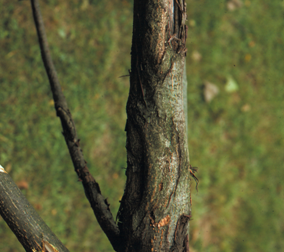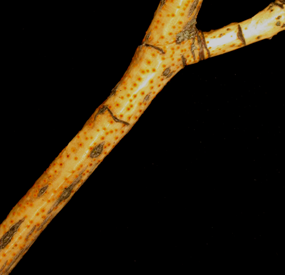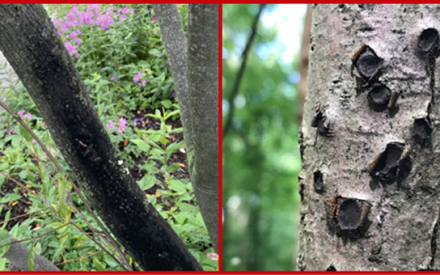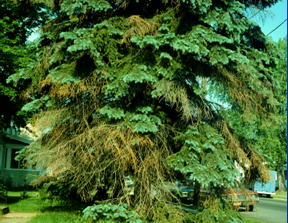
What is butternut canker?
Butternut canker is a fungal disease of Juglans cinerea, the butternut tree (also known as white walnut or oilnut). The disease is thought to have originated outside of the U.S. The first documented case of butternut canker in Wisconsin occurred in 1967. Butternut canker affects butternuts throughout their natural range (much of the eastern US) and has killed up to 80% of the butternut trees in some states. Although butternut canker can occur on saplings of black walnut (Juglans nigra), the effects of the disease on this species are minimal.
What does butternut canker look like?
Infected areas (called cankers) tend to be most noticeable on large branches or tree trunks, where long fissures in the bark form. Several cankers may grow together leading to bark that is distorted and has a mangled appearance. Smaller cankers also form around leaf or branch scars. These cankers are sunken and black, with white margins and folds of bark around the edge. Cankers girdle branches and trunks, cutting off nutrients and water, leading to progressive dieback above the canker. Trunk cankers will eventually kill trees. A single trunk canker can kill a young sapling, while several cankers combined may be needed to kill an older tree.
Where does butternut canker come from?
Butternut canker is caused by the fungus Ophiognomonia clavigignenti-juglandacearum. Spores of the fungus are produced in cankers throughout the growing season and are spread from infected to healthy trees through rain-splash, insects, and wind. Wounds, as well as leaf and branch scars, often serve as points of entry for the fungus. Once a tree is infected, additional infections can occur as spores are washed by rain down to the main trunk of the tree.
How do I save a tree with butternut canker?
There is no cure for butternut canker. Trees with trunk cankers will most likely die. If branch cankers are found early, removal of the affected branches can prevent the spread of the disease to other parts of the tree. Prune out smaller branch cankers by cutting six to eight inches below the canker. Disinfect pruning tools after each cut by treating them for at least 30 seconds with a 10% bleach solution or preferably (because of its less corrosive properties) a 70% alcohol solution (e.g., rubbing alcohol or certain spray disinfectants). If you use bleach, be sure to thoroughly rinse and oil tools after pruning to prevent rusting.
How do I avoid problems with butternut canker in the future?
There is little that you can do to prevent butternut canker. However, vigorously growing butternut trees are better able to slow the development of butternut canker, so make sure that trees are watered and fertilized properly. Established trees require approximately one inch of water per week. If natural rains do not provide this amount of water, consider applying supplemental water near the drip line of the tree using a drip or soaker hose. Fertilization of trees should be based on a soil nutrient test.
If you live in a region where butternut canker is not currently present, or where there are few butternut trees, your butternut tree may be free of cankers indefinitely. If you live in a region where butternut canker is prevalent, watch for trees that are not affected by the disease. These trees may have inherent resistance. Consider collecting seed from such trees and growing saplings from the seed. At least some of these saplings will likely also have resistance to the disease.
For more information on butternut canker:
Contact the University of Wisconsin Plant Disease Diagnostics Clinic (PDDC) at (608) 262-2863 or pddc@wisc.edu.
Authors: Rachel Leisso*, Montana State University Plant Sciences and Plant Pathology Brian Hudelson, UW-Madison Plant Pathology
Last Revised: 02/29/2024
D-number: D0027
*Completed as partial fulfillment of the requirements for Plant Pathology 699 – Plant Pathology Special Topics at the University of Wisconsin-Madison.
References to pesticide products in this publication are for your convenience and are not an endorsement or criticism of one product over similar products. You are responsible for using pesticides according to the manufacturer’s current label directions. Follow directions exactly to protect the environment and people from pesticide exposure. Failure to do so violates the law.
Thanks to Diana Alfuth, Lis Friemoth and Vijai Pandian for reviewing this document.
A complete inventory of UW Plant Disease Facts is available at the University of Wisconsin-Madison Plant Disease Diagnostics Clinic website: https://pddc.wisc.edu.
Send a Plant Sample for Analysis
Be cautious when self-diagnosing plant health issues. Very few diseases can accurately be diagnosed by eye.
Contact the UW Plant Disease Diagnostics Clinic (PDDC), and for a small fee, clinic staff can examine a plant, determine the cause of the disease/disorder, and provide advice on how to control or prevent the issue.
Download Article





 Bacterial Wetwood
Bacterial Wetwood Golden Canker (Cryptodiaporthe Canker)
Golden Canker (Cryptodiaporthe Canker) Blister Canker
Blister Canker Cytospora Canker
Cytospora Canker


